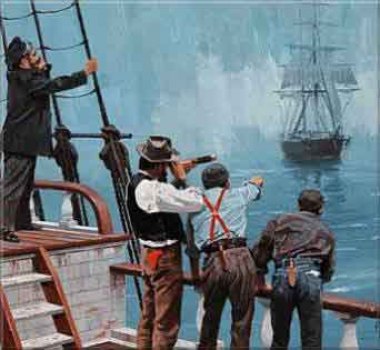
Back in the old days before high tech came to the high seas, whenever a vessel sailed out over the horizon, whatever happened aboard stayed aboard, at least until the vessel came in contact with another vessel or reached a port. And even then, it was a matter of whose story you chose to believe. Of course this situation allowed not only for a lot of salty yarns and tall tales, but quite a number of bone-chilling mysteries such as those of the Mary Celeste and the Carroll A. Deering.
Both of these were what came to be known as “ghost ships” when they were discovered with all sails set and no sign of passengers or crew. Pirates? Mutiny? Little green space aliens? We’ll probably never know but both ships became the subjects of interesting books written in 2002.
Stanley T. Spicer’s book, The Saga of the Mary Celeste: Ill-fated Mystery Ship tells of the ship’s discovery on December 4, 1872, adrift in the Atlantic some 600 miles west of Gibraltar. Although the sails were set and there was no sign of foul play aboard, there was not a trace of the ship’s yawlboat or its human complement of ten which included the captain’s wife and two-year-old daughter. Adding to the mystery was the fact that the cargo consisted of 1700 barrels of alcohol bound for Italy for the fortification of wine and that nine of those casks were found aboard [drum roll, please…] empty!
North Carolina’s own Bland Simpson wrote Ghost Ship of Diamond Shoals: The Mystery of the Carroll A. Deering which tells of the discovery of a five-masted schooner aground near Cape Hatteras on January 31, 1921. Again, the sails were set but there was no one aboard. Although there was no evidence of violence aboard, Simpson supplies enough background information to leave me with the strong suspicion of a mutiny.
Ah, the good old days which still afforded inexplicable mysteries… But wait! They can and do still pop up now and again. Why just five years ago the 30’ catamaran Kaz II was found adrift off the coast of Australia with both sails set, the engine running, and even a laptop computer on, but no sign of its three-man crew.
To my knowledge, nobody’s written a book about this one yet, but you can bet it’ll be at the top of my reading list when one finally comes out. Again, there was no evidence of a struggle, but, like the Mary Celeste the boat showed signs of having encountered bad weather (one of its two sails was badly torn). But in this age of G.P.S., V.H.F. radios and cell phones, it’s rather unusual for a vessel to get into serious trouble without alerting someone.
One interesting clue was a fishing lure fouled around the port rudder. Someone could have fallen overboard in an attempt to clear the lure. But all three?
Another possible clue was that the boat had fenders (soft inflated cushions) hanging over both sides. Since fenders are normally hung over the side only for docking or for tying alongside another vessel, most experienced sailors would stow them aboard when underway. (O.K., sometimes we forget. There are few things more embarrassing than being hailed on the radio by a passing boat in the Intracoastal Waterway to be informed that I’ve got a fender hanging over the side. Not me of course, but some sailors have been known to reply, “Thanks for the call but I’m preparing to dock up at this marina up ahead” and then actually make an unscheduled stop!)
Could someone have come alongside and abducted the crew? But why? And why wouldn’t they have communicated something about it? The ocean continues to keep her secrets. Even in this day and age.